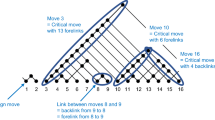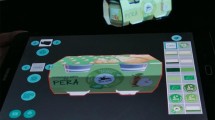Abstract
This paper reports the results of a protocol study which explores behavior of designers while they design in pairs using sketching (analogue and remote) and 3D modeling tools (co-located and remote) in co-located and remote locations. The design protocol videos were collected, transcribed, segmented and coded with the customized coding scheme. The coded protocol data was examined to understand the changes of designers’ co-design process and their activities of making representation in four different settings. This paper discusses the impact of location and types of representation on collaborative design. The paper concludes that designers were able to adapt their collaboration and design strategies in accordance with the affordability of the used digital environments.
Access this chapter
Tax calculation will be finalised at checkout
Purchases are for personal use only
Similar content being viewed by others
References
Arias, E., Eden, H., Fischer, G., Gorman, A., Scharff, E.: Transcending the individual human mind—creating shared understanding through collaborative design. ACM Trans. Comput. Hum. Interact. 7(1), 84–113 (2000). doi:10.1145/344949.345015
Kim, M., Maher, M.L.: Comparison of designers using a tangible user interface & graphical user interface and impact on spatial cognition. In: Proceedings of International Workshop on Human Behaviour in Designing, Melbourne, Victoria, pp. 81–94 (2005)
Seichter, H., Schnabel, M.A.: Digital and tangible sensation: an augmented reality urban design studio. In: 10th International Conference on Computer Aided Architectural Design Research in Asia, CAADRIA, New Delhi, India (2005). doi:10.1007/978-1-4020-6528-6_1
Ko, C.H., Chang, T.C.: Evaluation and student perception of augmented reality-based design collaboration. Management 6(6), 6 (2011)
Anders, P., Lonsing, W.: Ambiviewer: a tool for creating architectural mixed reality. In: ACAADI, pp 104–113 (2005)
Sung, W.: Sketching in 3D Towards a Fluid Space for Mind and Body. SMArch Thesis. MIT Architecture, Cambridge (2013)
De Vries, B.: Sketching in 3D. In: ECAADE, pp. 277–280 (2013)
Schnabel, M.A., Kvan, T.: Design, communication & collaboration in immersive virtual environments. Int. J. Des. Comput. Spec. Issue Des. Virtual Worlds 4 (2002)
Kvan, T., Vera, A., West. R.: Expert and situated actions in collaborative design. In: 2nd International Workshop on Computer Support Cooperative Work in Design. International Academic Publisher, Beijing (1997)
Gül, L.F.: Understanding Collaborative Design in Different Environments. University of Sydney, Ph.D. Thesis, Australia (2007)
Bowen, S., Durrant, A., Nissen, B.: The value of designers’ creative practice within complex collaborations. Des. Stud. 46, 174–198 (2016). doi:10.1016/j.destud.2016.06.001
Leon, M., Doolan, D.C., Laing, R., Malins, J., Salman, H.: Application of interactive surfaces to support computer mediated collaborative design environment. In: 18th International Conference on Information Visualisation (2014). doi:10.1109/IV.2014.30
Lee, S., Ezer, N., Sanford, J., Do, E.Y.: Designing together while apart: the role of computer-mediated communication and collaborative virtual environments on design collaboration. In: IEEE International Conference on Systems, Man and Cybernetics (2009). doi:10.1109/ICSMC.2009.5346849
Remko, V.: Functions of sketching in design idea generation meetings. In: C&C’ 02, ACM, Loughborough, Leic (2002)
Gül, L.F., Maher, M.L.: Co-creating external design representations: comparing face-to-face sketching to designing in virtual environments. Co-Design 5(2), 117–138 (2009)
Porter, T., Neale, J.: Architectural Supermodels. Architectural Press, Oxford (2000)
Achten, H., Joosen, G.: The digital design process-reflections on a single design case. In: Digital Design, 21st ECAADe Conference Proceedings, Graz, Austria, pp. 269–274 (2013)
Laseau, P.: Graphic Thinking for Architects and Designers. Van Nostrand Reinhold, New York (1989)
Raskin, J.: The Human Interface: New Directions to Design Interactive Systems. Addison Wesley, Boston (2000)
Eckert, C., Boujut, J.: The role of objects in design co-operation: communication through physical or virtual objects. Comput. Support. Coop. Work 12, 145–151 (2003). doi:10.1023/A:1023954726209
Maher, M.L., Bilda, Z., Gül, L.F.: Impact of collaboratve virtual environments on design behaviour. In: Gero, J. (ed.) Design Computing and Cognition’06, pp. 305–321. Springer, Netherlands (2006)
Gül, L.F., Halıcı, S.M., Uzun, C., Esengün, M.: Understanding the impact of mobile augmented reality on co-design cognition and co-modeling. In: Luo, Y. (ed) Cooperative Design, Visualization, and Engineering, 13th International Conference, CDVE 2016, Sydney, NSW, Australia (2016)
Watson, J.: Is thinking merely the action of language mechanism? Br. J. Psychol. 11, 87–104 (1920). doi:10.1348/000712608X336095
Eastman, C.: Explorations of the Cognitive Processes in Design. Department of Computer Science Report, Carnegie Mellon University, Pittsburgh (1968)
Ericsson, K., Simon, H.: Protocol Analysis: Verbal Reports as Data. MIT Press, Cambridge (1984)
Eppler, M.J., Kernbach, S.: Dynagrams: enhancing design thinking through dynamic diagrams. Des. Stud. 47, 91–117 (2016). doi:10.1016/j.destud.2016.09.001
Suwa, M., Tversky, B.: What do architects and students perceive in their design sketches? A protocol analysis. Des. Stud. 18, 385–403 (1997). doi:10.1016/S0142-694X(97)00008-2
Vygotsky, L.: Thought and Language. MIT Press, Cambridge, MA (1986)
Goldschmidt, G.: Designer as a team of one. Des. Stud. 16, 189–209 (1995)
Gabriel, G., Maher, M.L.: Coding and modeling communication in architectural collaborative design. In: Ataman, O., Bermudez, J. (eds) ACADIA’99, pp. 152–166 (1999). doi:10.1016/S0926-5805(00)00098-4
Gero, J.S., Neill, T.M.: An approach to the analysis of design protocols. Des. Stud. 19, 21–61 (1998). doi:10.1016/S0142-694X(97)00015-X
Vera, A.H., Kvan, T., West, R.L., Lai, S.: Expertise, collaboration and bandwidth. In: Proceedings of the SIGCHI Conference on Human Factors in Computing Systems, pp. 502–510 (1998). doi:10.1145/274644.274712
Cross, N.: Natural intelligence in design. Des. Stud. 20, 25–39 (1999). doi:10.1016/S0142-694X(98)00026-X
Gül, L.F.: Evaluating software support for multimedia data analysis in design studies. In: Computer-Aided Qualitative Research Europe: Lisbon University (workshop) (2010)
Alonso, H.V., Kvan, T., West, R.W., Lai, S.: Expertise, collaboration and bandwidth. In: CHI (1998)
Dourish, P.: The appropriation of interactive technologies: some lessons from placeless documents. JCSCW 12(4), 465–490 (2003). doi:10.1023/A:1026149119426
Muller, M., Neureiter, K., Verdezoto, N., Krischkowsky, A., Zubaidi-Polli, A.M., Tscheligi, M.: Collaborative appropriation: how couples, teams, groups and communities adapt and adopt technologies. In: CSCW’16 Companion, San Francisco, CA, pp. 473–480 (2016). doi:10.1145/2818052.2855508
Cardella, M.E., Atman, C.J., Adams, R.S.: Mapping between design activities and external representations for engineering student designers. Des. Stud. 27, 5–24 (2006). doi:10.1016/j.destud.2005.05.001
Maher, M.L., Bilda, Z., Gu, N., Gül, L.F, Marchant, D.: Collaborative Process: Research Report on Use of Virtual Environment. The University of Sydney (2005)
Acknowledgements
This research is funded by TÜBİTAK under project number 115K515 titled as ‘A study of co-design cognition in virtual environments: Do presence and types of representation change design behavior? The authors wish to thank the participants of the study.
Author information
Authors and Affiliations
Corresponding author
Editor information
Editors and Affiliations
Rights and permissions
Copyright information
© 2017 Springer Nature Singapore Pte Ltd.
About this paper
Cite this paper
Gül, L.F., Uzun, C., Halıcı, S.M. (2017). Studying Co-design. In: Çağdaş, G., Özkar, M., Gül, L., Gürer, E. (eds) Computer-Aided Architectural Design. Future Trajectories. CAADFutures 2017. Communications in Computer and Information Science, vol 724. Springer, Singapore. https://doi.org/10.1007/978-981-10-5197-5_12
Download citation
DOI: https://doi.org/10.1007/978-981-10-5197-5_12
Published:
Publisher Name: Springer, Singapore
Print ISBN: 978-981-10-5196-8
Online ISBN: 978-981-10-5197-5
eBook Packages: Computer ScienceComputer Science (R0)




